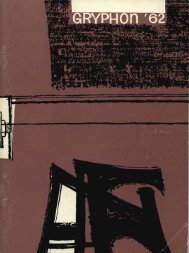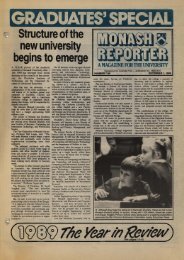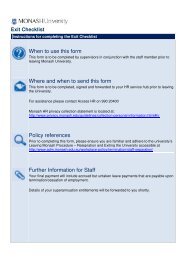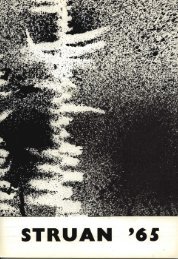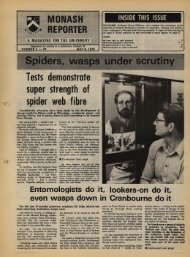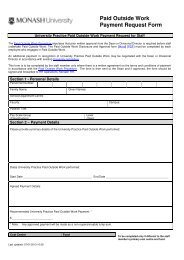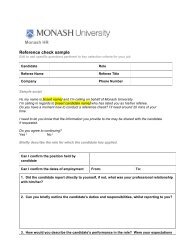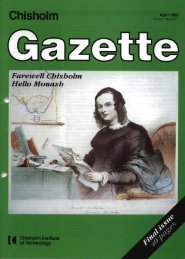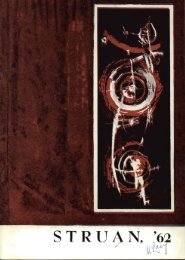GAZETTE - Adm.monash.edu.au - Monash University
GAZETTE - Adm.monash.edu.au - Monash University
GAZETTE - Adm.monash.edu.au - Monash University
- No tags were found...
You also want an ePaper? Increase the reach of your titles
YUMPU automatically turns print PDFs into web optimized ePapers that Google loves.
matriculation physics in Victoria in 1966.The survey yielded information on a number of areasincluding comments and opinions of teachers on the appropriatenessand effectiveness of the course; conditionsfor teaching physics in Victorian secondary schools;teaching practices being used in the teaching of physicsin schools and the qualifications and experience ofphysics teachers. A full report of the results of thissurvey is published elsewhere."l2) COMPARATIVE STUDI~SThe major justification given for a change in any ofthe materials in a course is that it will lead to improvementin the quality of instruction. Once materials havebeen shown to be feasible, it is nearly always considerednecessary to demonstrate that pupil learning under thenew course is superior to that under the older "moretraditional" course.Comparisons such as this can yield valuable informationon the relative merits and weaknesses of courses.A study of this type has been completed by the <strong>au</strong>thorin which the A.C.E.R. pre-matriculation physics examinationwas used to compare the performance of studentsat the end of the P .S.S.C. physics course and the previousphysics course in Victorian secondary schools."In this study the performance of a sample of 484 matriculationphysics students who had studied the P .S.S.c.physics course in 1966 was tested with this examinationand their performance compared with that of the studentsof the previous physics course who took the examinationin 1961 and 1964.In another study a comparison is being made of theperformance of Queensland students studying theP.S.S.C. course and students studying the traditionalphysics course in Queensland during 1967 and 1968.Hopefully, this will provide evidence on areas in whichP.S.S.c. physics is being less successful relative to theprevious Queensland physics course than we would like.The value of any comparative study should be toidentify the relative strengths and weaknesses of thecourses concerned. It is all too easy to use such arestricted test battery that one course will appearsuperior to the other when, in fact, if students had beentested on all relevant areas it would be more realisticto expect relative strengths of one course to be offsetby weaknesses in other areas.Another extremely important difficulty in using comparativestudies is the selection of the comparison groupor comparison course. It is all too easy to line a courseup against a wooden-legged competitor and concludethat this course is a far superior course to any other.(3) COMPARISON WITH EXPECTATIONS STUDIESBec<strong>au</strong>se of the difficulties in comparing one coursewith another, it is usually more acceptable to compare1 L. D. Mackavs-c''Phvsics teaching in Victoria", AustralianJournal of Education, 12, No.2, in press.2 L. D. Mackay.-"A comparative study of the performanceof P.S.S.c. physics students (1966) and studentsof the previous physics course (1964), using theA .C.E.R. Pre-Matriculation Physics Examination",Australian Science Teachers' Journal, 14, No.1, inpress.3 L. D. Mackay. -Physics Supplement to V.U.SE.B.Circulars to Schools, Nos. 17 and 10.the achievements of a course with the teacher's expectations of the course. This involves measurement of thechange in students that occur as they study the courseand a comparison of the observed student achievementand the desired changes in pupil behaviour implied bythe objectives of the course. For some purposes it issufficient to note the performance of students at the endof the course and compare this with our expectations. Inother situations we are more concerned with identifyingthe particular changes of behaviour or achievement thatoccur as the student studies a course.A serious difficulty which arises in any attempt tomeasure changes is in attributing the changes to thecourse of study concerned. An individual, in the courseof a year, undergoes so many different and variedlearning experiences outside the course of study that itis extremely difficult, if not impossible, 10 conclude thatany observed change in the individual is a direct resultof the course concerned. However, if the gains are notup to expectation it is perfectly reasonable to acceptthis as evidence of a deficiency in the course, bec<strong>au</strong>se ifthe course were successful the students as a groupshould be expected to achieve the objectives of thecourse. Thus this type of comparison of the actual outcomeswith the expectations of a course is a morepowerful tool in identifying weaknesses in a course thanin identifying: specific strengths of a course. Whereasit might be intellectually satisfying to know that studentsare achieving the objectives of a course directly as aresult of that course, it is sufficient in the <strong>edu</strong>cationalsense to know that the objectives are being achieved bythe students, without being able to say with any certaintythat the course can take the credit.In the P.S.S.c. evaluation projects being conducted bythe <strong>au</strong>thor, both the technique of considering only theperformance achieved by students at the end of a courseand the technique of observing the gains made by studentsas they study a course are being employed inseparate studies.The performance of students at the end of each of thetwo years of the P.S.S.c. physics course has been usedin detailed analysis of scripts for the matriculation andleaving physics examinations conducted by theV.U.S.E.B. in 1966 and 1967. These analyses" haveyielded valuable information on topics which wereproving of difficulty to students studying the P .5.S.c.course and topics or areas of the course in which theteaching was being less successful than desired.In the project being conducted with the assistance ofa grant from the Australian Research Grants Committee,it is intended to obtain information on the changes thatoccur in students in a random sample of sixty Victoriansecondary schools as they study the leaving and matriculationphysics courses during 1967 and 1968. In thisstudy an attempt has been made to define precisely theobjectives of the P.S.S.c. physics course. This has beenachieved by a survey of the literature and by consultationwith physics teachers in schools and universities.The difficulty was not in finding possible objectives forthe course but in deciding which objectives are theimportant ones.A battery of tests has been developed to measure thechanges in knowledge, intellectual skills, attitudes andcognitive preferences in students and has been used inFebruary 1967 to test some 1500 leaving physics studentsat the commencement of their study of the P.S.S.C.23




